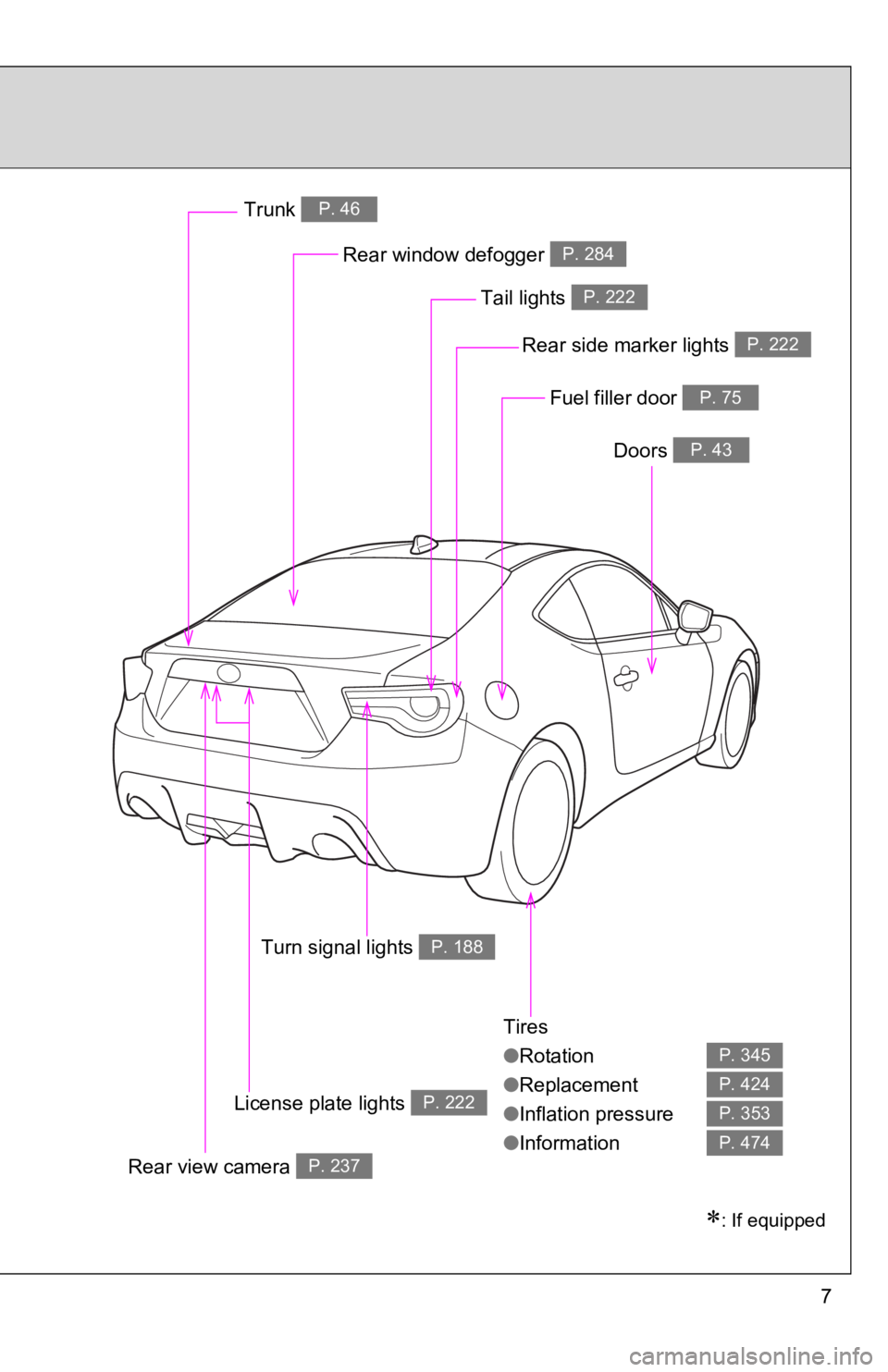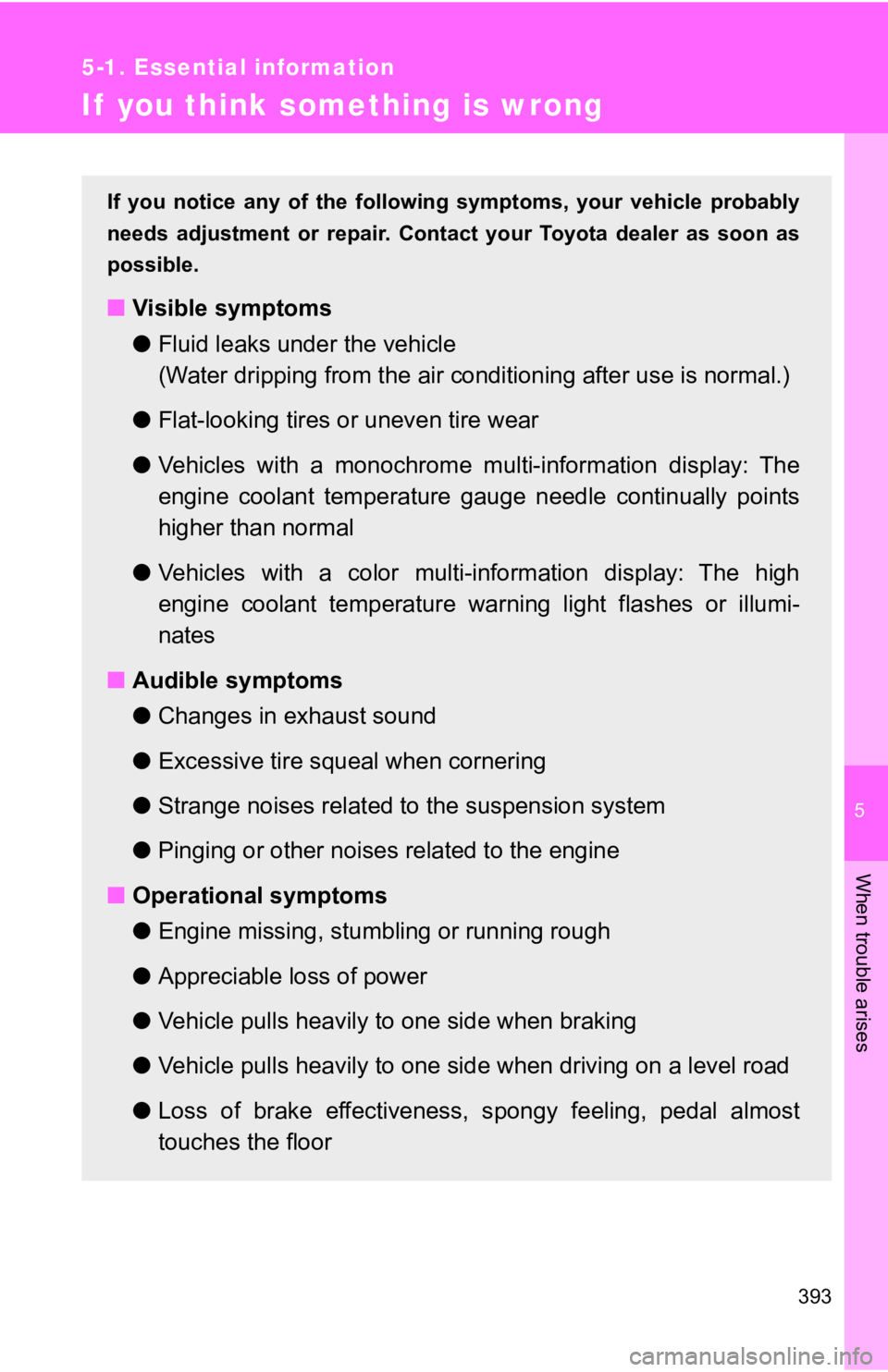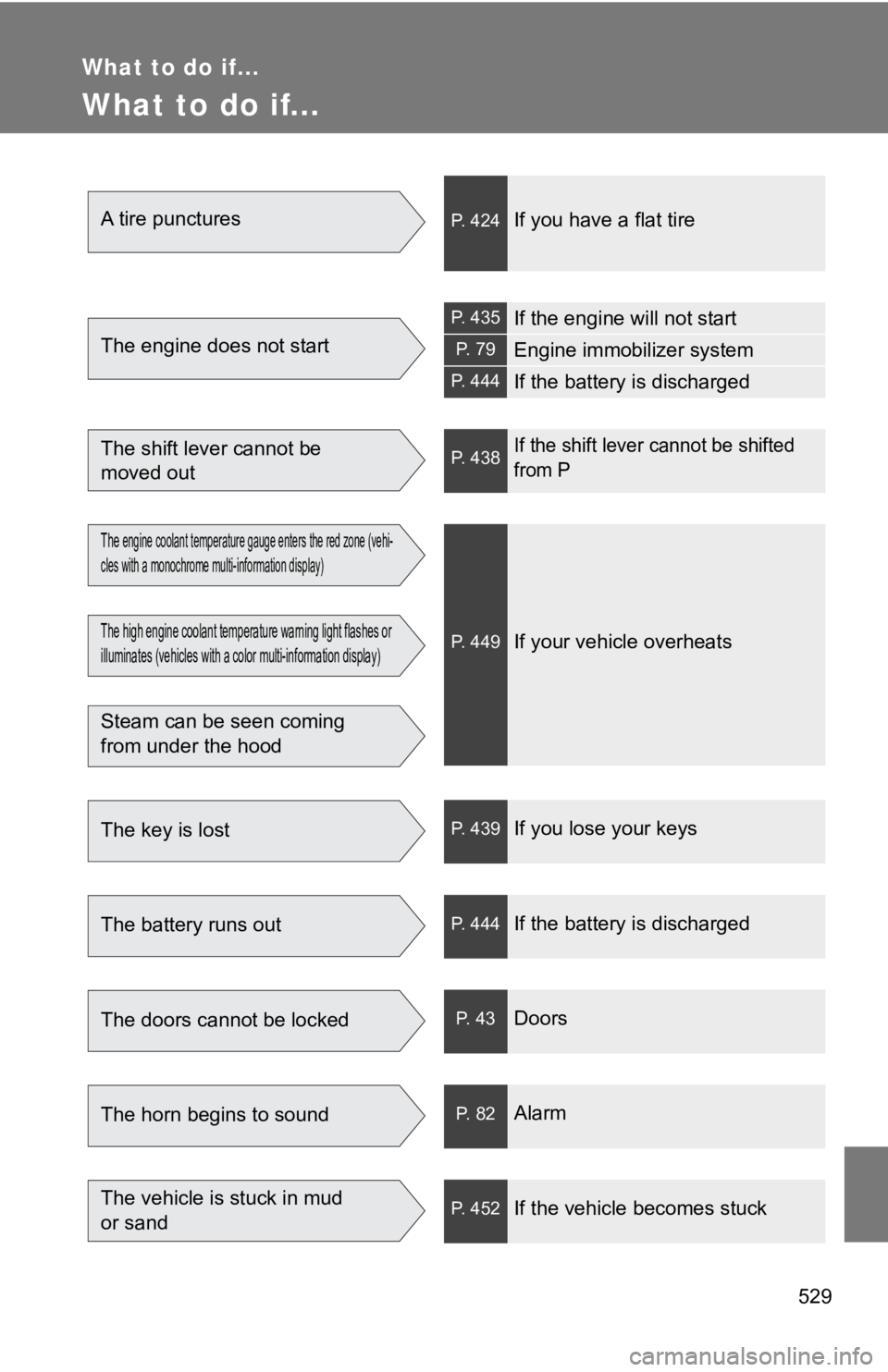run flat TOYOTA GT86 2018 Owners Manual (in English)
[x] Cancel search | Manufacturer: TOYOTA, Model Year: 2018, Model line: GT86, Model: TOYOTA GT86 2018Pages: 532, PDF Size: 6.46 MB
Page 7 of 532

7
Tires
●Rotation
● Replacement
● Inflation pressure
● Information
P. 345
P. 424
P. 353
P. 474
Rear window defogger P. 284
Trunk P. 46
Doors P. 43
Fuel filler door P. 75
Tail lights P. 222
Rear side marker lights P. 222
Turn signal lights P. 188
: If equipped
License plate lights P. 222
Rear view camera P. 237
Page 140 of 532

140 1-7. Safety information
WARNING
■Child restraint precautions
●Do not allow the child to lean his/her head or any part of his/ her body
against the door or the area of the seat, front and rear pillar s or roof side
rails from which the SRS side airbags or SRS curtain shield air bags deploy
even if the child is seated in the child restraint system. It i s dangerous if
the SRS side airbags and curtain shield airbags inflate, and the impact
could cause death or serious injury to the child.
● Make sure you have complied with all installation instructions provided by
the child restraint manufacturer and that the system is properly secured. If
it is not secured properly, it may cause death or serious injur y to the child
in the event of a sudden stop, sudden swerve or an accident.
■ When children are in the vehicle
Do not allow children to play with the seat belt. If the seat b elt becomes
twisted around a child’s neck, it may lead to choking or other serious injuries
that could result in death.
If this occurs and the buckle cannot be unfastened, scissors sh ould be used
to cut the belt.
■ When the child restrai nt system is not in use
● Keep the child restraint system properly secured on the seat ev en if it is
not in use. Do not store the restraint unsecured in the passeng er compart-
ment.
● If it is necessary to detach the child restraint system, remove it from the
vehicle or store it securely in the trunk. This will prevent it from injuring
passengers in the event of a sudden stop, sudden swerve or acci dent.
Page 243 of 532

243
2-4. Using other driving systems
2
When driving
WARNING
■
When using the rear view monitor system
Observe the following precautions to avoid an accident that cou ld result in
death or serious injuries.
● The rear view monitor system is a supplement device intended to assist
back up. Never depend solely on the rear view monitor system wh en
reversing. Always check visually and with the mirrors to confir m your
intended path is clear. Use caution just as you would when back ing up any
vehicle.
● The camera has a special lens. Depicted distances between objec ts and
flat surfaces differ from actual distances.
● Always check the vehicle surrounding area, because the guide li nes are
ancillary lines.
● The guide lines are ancillary lines and do not change even if t he steering
wheel is turned.
● Do not use the system if the trunk is open.
■ Conditions which may affect t he rear view monitor system
● If the back of the vehicle has been hit, the camera’s position and mounting
angle may have changed. Have the vehicle inspected by your Toyota
dealer.
● When the outside temperature is low, the displayed image may be come
faint or dark, and moving images will be distorted, or not entirely visible.
● Rapid temperature changes, such as when hot water is poured on the
vehicle in cold weather, may cause the system to function abnor mally.
● If the camera lens is dirty, it cannot transmit a clear image. Rinse with
water and wipe with a soft cloth. If the camera lens is extreme ly dirty, wash
with a mild cleanser and rinse.
● If the tire size is changed, the area displayed on the screen may change.
● Do not do the following. Doing so may scratch the lens, which may have a
negative effect on the image displayed on the screen.
• Rub the camera lens hard
• Use a hard brush to scrub the camera lens
• Scrub the lens with abrasive cleaners
Page 322 of 532

322 4-2. Maintenance
Vehicle exterior
ItemsCheck points
Door/trunk • Operate smoothly?
Engine hood • The lock system works properly?
Fluid leaks • Is there any leakage after park-
ing?
Tire • Inflation pressure is correct?
• Tire surfaces not worn or dam-
aged?
• Tires rotated according to the maintenance schedule?
• Wheel nuts are not loose?
Windshield wipers
•The wiper blades should not show
any signs of cracking, splitting,
wear, contamination or deforma-
tion.
•The wiper blades should clear the
windshield without streaking or
skipping.
WARNING
■ If the engine is running
Turn the engine off and ensure that there is adequate ventilation before per-
forming maintenance checks.
Page 385 of 532

5
When trouble arises
385
5-1. Essential information
If your vehicle needs to be towed
Before towingThe following may indicate a problem with your transmission. Co ntact
your Toyota dealer before towing.
● The engine is running, but t he vehicle will not move.
● The vehicle makes an abnormal sound.
Emergency towing
If a tow truck is not available in an emergency, your vehicle m ay be
temporarily towed using a cable or chain secured to the emergen cy
towing eyelet. This should only be attempted on hard surfaced r oads
for short distances at low speeds.
A driver must be in the vehicle to steer and operate the brakes . The
vehicle’s wheels, drive train, axles, steering and brakes must be in
good condition.
For vehicles with an automatic transmission, only the front towing
eyelet may be used.
If towing is necessary, we recommend having your vehicle towed by
your Toyota dealer or a commerci al towing service, using a lift-type
truck or a flat bed truck.
Use a safety chain system for all towing, and abide by all stat e/pro-
vincial and local laws.
If towing from the rear, the vehicle's front wheels and axles m ust be
in good condition. ( P. 391)
If they are damaged, use a to wing dolly or flat bed truck.
Page 393 of 532

5
When trouble arises
393
5-1. Essential information
If you think something is wrong
If you notice any of the following symptoms, your vehicle proba bly
needs adjustment or repair. Cont act your Toyota dealer as soon as
possible.
■ Visible symptoms
●Fluid leaks under the vehicle
(Water dripping from t he air conditioning after use is normal.)
● Flat-looking tires or uneven tire wear
● Vehicles with a monochrome multi-information display: The
engine coolant temperature gauge needle continually points
higher than normal
● Vehicles with a color multi-information display: The high
engine coolant temperature wa rning light flashes or illumi-
nates
■ Audible symptoms
●Changes in exhaust sound
● Excessive tire squeal when cornering
● Strange noises related to the suspension system
● Pinging or other noises related to the engine
■ Operational symptoms
●Engine missing, stumbling or running rough
● Appreciable loss of power
● Vehicle pulls heavily to one side when braking
● Vehicle pulls heavily to one side when driving on a level road
● Loss of brake effectiveness, s pongy feeling, pedal almost
touches the floor
Page 403 of 532

5
When trouble arises
403
5-2. Steps to take in an emergency
■If the tire pressure warn
ing system is inoperative
The tire pressure warning system will be disabled in the following condi-
tions:
(When the condit ion becomes normal, the system will work properly.)
●If tires not equipped with tire pressure warning valves and tra nsmit-
ters are used.
●If the ID code on the tire pressure warning valves and transmit ters is
not registered in the tire pressure warning computer.
●If the tire inflation pressure is 55 psi (380 kPa, 3.87 kgf/cm2 or bar) or
higher.
The tire pressure warning system may be disabled in the followi ng condi-
tions:
(When the condit ion becomes normal, the system will work properly.)
●If electronic devices or facilities using similar radio wave fr equencies
are nearby.
●If a radio set at similar frequen cies is in use in the vehicle.
●If a window tint that affects the radio wave signals is install ed.
●If there is a lot of snow or ice on the vehicle, in particular around the
wheels or wheel housings.
●If non-genuine Toyota wheels are used. (Even if you use Toyota
wheels, the tire pressure warning system may not work properly with
some types of tires.)
●If tire chains are used.
●If a large metallic object which can interfere with signal reception is
put in the trunk.
■If the tire pressure warning light frequently comes on after bl inking
for approximately one minute
If the tire pressure warning light frequently comes on after bl inking for
approximately one minute when the “ENGINE START STOP” switch is
turned to IGNITION ON mode (vehicles with a smart key system) o r the
engine switch is turned to the “ON” position (vehicles without a smart key
system), have it check ed your Toyota dealer.
Page 431 of 532

5
When trouble arises
431
5-2. Steps to take in an emergency
WARNING
■Using the tire jack
Improper use of the tire jack may lead to death or serious inju
ries due to
the vehicle suddenly falling off the jack.
●Do not use the tire jack for any purpose other than replacing t ires or
installing and removing tire chains.
●Only use the tire jack that comes with this vehicle for replacing a flat
tire.
Do not use it on other vehicles, and do not use other tire jack s for
replacing tires on this vehicle.
●Always check that the tire jack is securely set to the jack point.
●Do not put any part of your body under the vehicle supported by a jack.
●Do not start or run the engine while your vehicle is supported by the
jack.
●Do not raise the vehicle while someone is in it.
●When raising the vehicle, do not put an object on or under the jack.
●Do not raise the vehicle to a height greater than that required to
replace the tire.
●Use a jack stand if it is necessary to get under the vehicle.
Take particular care when lowering the vehicle to ensure that n o one
working on or near the vehicle may be injured.
Page 434 of 532

434 5-2. Steps to take in an emergency
NOTICE
■Do not drive the vehicle with a flat tire.
Do not continue drivi ng with a flat tire.
Driving even a short distance wi th a flat tire can damage the tire and the
wheel beyond repair.
■Be careful when driving over bumps with the compact spare tire
installed on the vehicle.
The vehicle becomes lower when d riving with the compact spare tire
compared to when driving with standard tires. Be careful when d riving
over uneven road surfaces.
■Driving with tire chains and the compact spare tire
Do not fit tire chains to t he compact spare tire.
Tire chains may damage the vehicle body and adversely affect dr iving
performance.
■When replacing the tires
When removing or fitting the wheels, tires or the tire pressure warning
valve and transmitter, contact yo ur Toyota dealer as the tire pressure
warning valve and transmitter ma y be damaged if not handled correctly.
■To avoid damage to the tire pressure warning valves and transmi t-
ters
When a tire is repaired with liquid sealants, the tire pressure warning
valve and transmitter may not operate properly. If a liquid sea lant is
used, contact your Toyota dealer or other qualified service shop as soon
as possible. Make sure to replace the tire pressure warning val ve and
transmitter when replacing the tire. ( P. 3 4 6 )
■Stowing the jack
When stowing the jack in the jack holder, make sure that the pa rt that the
jack handle attaches to is pointing towards the inside of the t runk. Failure
to do so may damage the vehicle body.
Page 529 of 532

529
What to do if...
What to do if...
A tire puncturesP. 424If you have a flat tire
The engine does not start
P. 435If the engine will not start
P. 79Engine immobilizer system
P. 444If the battery is discharged
The shift lever cannot be
moved outP. 438If the shift lever cannot be shifted
from P
The engine coolant temperature gauge enters the red zone (vehi-
cles with a monochrome multi-information display)
The high engine coolant temperature warning light flashes or
illuminates (vehicles with a color multi-information display)
Steam can be seen coming
from under the hood
P. 449If your vehicle overheats
The key is lostP. 439If you lose your keys
The battery runs outP. 444If the battery is discharged
The doors cannot be lockedP. 43Doors
The horn begins to soundP. 82Alarm
The vehicle is stuck in mud
or sandP. 452If the vehicle becomes stuck